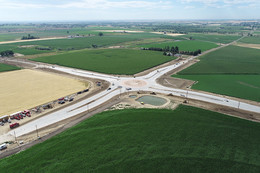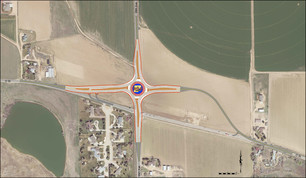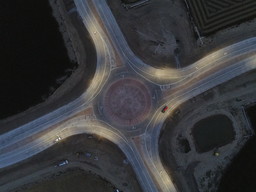|
|
You spoke, and we listened. Last fall, we asked readers to participate in a survey about this newsletter, including asking for suggestions on improvement. The feedback we received from you is incorporated in our County Roots refresh: larger font size, more pictures, the inclusion of a Q &A, and more history items (history tidbits and Q&A will alternate issues). We hope you enjoy the improvements, and thank you for subscribing to this newsletter! Jennifer Finch, Weld County PIO.

I don’t like roundabouts. Perhaps more accurately, I don’t do roundabouts.
If I approach one unexpectedly, the nerves in my stomach cause my head to look frantically for a side street, or yes, parking lot to cut through to avoid taking it. If GPS directions forecast me taking one, I can’t hit the “alternate route” button quickly enough — extra travel time never factors into the decision — and if there’s no way to avoid one, I seriously consider if I really need to travel to my end destination. In the off chance I am forced to go through one, get ready for a heavy dose of complaining followed by my continual championing of the more traditional traffic control methods like the stoplight and stop sign.
So, when I first heard about plans to construct a roundabout at Weld County Road (WCR) 54 and 17 at Weld County Public Works’ 2019 Capital Improvement Plan (CIP) meeting, or more recently, plans to begin construction of a roundabout at 35th and O Street this year, several thoughts crept into my head encompassing anxiety, frustration and confusion.
Are you kidding me?! These things don’t work! Why are we doing this? Great. Now how am I going to get to work?
Rather than let my one-sided — and some might say close-minded — opinions continue to stew in my mind and affect my driving habits, I set out to learn more about roundabouts and just why they’ve arrived in Weld County.
|

Safety, efficiency and cost savings
The roundabout has come a long way since it was first introduced in 1905 in New York City by William Phelps Eno — a design that failed due to traffic entering the roundabout not having to yield. Research shows that after British engineer Frank Blackmore perfected the modern roundabout in the 1960s, American engineer Leif Ourston — with Blackmore’s help — brought the idea of the roundabout back to America, more specifically to California, in the 1980s.
However, the first modern roundabouts appeared in Nevada in the 1990s, according to the Insurance Institute for Highway Safety. For many years, roundabouts were only used in high-traffic urban areas. So, what’s changed in Weld County that’s led Public Works engineers to lean toward a roundabout as a way of safely and efficiently moving traffic through an intersection like at 35th Avenue and O Street? The answer revolves around continued growth.
Be it the fact that in the last decade, Weld County’s population has increased 30%, according to U.S. Census Data or the state demographer's five-year increment chart showing the county’s population doubling by 2050 from its 2010 total, the demand on the county’s transportation system continues to increase and county engineers continually look for ways to provide safety improvements to the county’s transportation system to ensure it meets demand.
The county’s first roundabout at WCR 54 and 17 has successfully addressed issues related to congestion and accidents. In 2018, traffic data showed the intersection was responsible for 22 crashes across seven years — 7th highest among county-controlled intersections. While that number may not seem like a lot, given that the projected traffic growth rate for the area is 3.52% annually and would add to the more than 11,000 vehicles traveling through the intersection daily, a roundabout was installed to alleviate congestion and improve safety. Since opening in August of 2020, the results of the roundabout have been extremely positive.
“Converting this four-way stop to a roundabout has significantly improved traffic flow and air quality at this location,” Weld County senior engineer Cameron Parrot said.
For those who wonder why a stoplight wasn’t installed at WCR 54 and 17 or won’t be installed at 35th Avenue and O Street, it’s not that they’re never considered. In the case of the roundabout at WCR 54 and 17, the Freedom Parkway Access Control Plan, approved in 2018 — and a framework for making future safety and mobility improvements along a 25-mile road that includes WCR 54 — requires agencies in the Freedom Parkway Coalition to analyze the feasibility of a roundabout in locations that warrant traffic signals. So, analysis of a traffic signal and roundabout as a traffic control measure for the intersection was performed. However, it comes down to what Public Works is trying to alleviate, which is crash risk and fatalities. Ultimately, data shows roundabouts are safer than traffic signals. Additionally, they cut down substantially on wait times when trying to get through an intersection, which for those traveling through the 35th Avenue and O Street intersection, are felt largely during the evening commute.
|

“Anytime an intersection meets the criteria for a stoplight, Public Works also evaluates a roundabout option,” Parrott said, explaining that a stoplight could create a similar delay currently being experienced at the four-way stop. “You have a lot of vehicles that can stack up at a stoplight. Roundabouts can help improve that.”
Construction of the 35th and O Street roundabout will be performed by IHC Scott after the Board of Commissioners awarded the company the project for just over $7.4 million on January 31. To help leverage the cost, the project is being partially funded with a $750,000 Energy and Mineral Impact grant from the Department of Local Affairs and a $1.6 million investment from the City of Greeley. Even with the expense upfront to construct the roundabout, it’s significantly cheaper in the long run compared to a stoplight.
“We would have to convert an existing two-lane into a five-lane road to easily allow all the needed turn movements at a stoplight,” Weld County senior engineer Don Dunker said. “Then, when we would have to replace the asphalt, we’d likely have to replace all five lanes. There are also ongoing electrical costs and specialized maintenance to consider with a stoplight. With this roundabout, we are making the lanes out of concrete to hopefully achieve a 30-year life with minimal future maintenance.”
Much work also went into the design of the roundabout to allow it the flexibility to adjust in the future without the need for more construction.
“This roundabout design will allow us to build the footprint for the ultimate configuration, which will involve two circulating lanes, but only stripe the interim setup as a single circulating lane roundabout,” Parrott explained. “Single circulating lane roundabouts are much simpler to navigate and will remain functional for quite some time before improvements would be needed. When those improvements are needed, a simple change to the roadway striping will allow the roundabout to expand to two circulating lanes, basically doubling the capacity of the intersection without having to deal with another major construction project.”
|

Cracking the “unfamiliar” argument
While I can’t argue with the results at WCR 54 and 17 or with Federal Highway Administration data showing roundabouts reduce accidents and fatalities, the fact that they’re unfamiliar to many draws my ire. Four-way stops can be complicated enough. Do we really need vehicles moving at the same time to add more confusion to the daily commute?
Perhaps I’m just overthinking this.
“We’ve been teaching how to drive through them for years,” said Kris Klemmer, manager at Anshor Driving School in Greeley. “I used to not like roundabouts, but I also don’t like waiting at stop signs. And anything that can reduce traffic fatalities is a good thing.”
Klemmer admitted that I wasn’t alone in my dislike of roundabouts, but as with anything new, she said repetition, not avoidance, is key to accepting them. She suggested the following tips for drivers new to roundabouts as well as those familiar with them:
- Practice going through roundabouts at a time when there is not as much traffic, such as the middle of the day.
- Incoming drivers should always yield to people coming from the left and avoid cutting in at the last second.
- Have an idea of what lane you need to be in before entering the roundabout.
- When exiting a roundabout, use your turn signal. This helps incoming drivers know if they can enter.
It’s also important to point out that many steps are taken in the design phase of county roundabouts to ensure they meet the needs of both urban and rural travelers. In addition to the lanes being made of concrete to lessen the need for repairs, the lanes are also significantly wider to accommodate large agricultural and commercial vehicles.
Whether I like it or not, roundabouts will keep coming to Weld County if identified as the best method of meeting traffic demand and improving intersection safety, something done after Public Works evaluates five years’ worth of traffic and intersection data and presents the option of a roundabout to the Board Commissioners. Roundabouts may take some getting used to, but they are a solution to safely moving people throughout the county not only today, but also in the future.
That, I can appreciate.
|
By Baker Geist, Weld County Communications Specialist
|
|
The WCR 54 and 17 roundabout was named 2021's top county road project by the Colorado/Wyoming Chapter of the American Concrete Pavement Association. |
The contract for the 35th and O Street roundabout was awarded to IHC Scott January 31. Construction is slated to begin later this month or in March. |
For-single lane roundabouts, like the one that will be constructed at 35th Avenue and O Street, the capacity is 25,000 vehicles per day, according to Public Works. |
|
|
Weld County's 2022 12 Months of Emergency Preparedness Tips
The idea of planning for emergencies can seem like a daunting task, but a little thought and conversation can make getting started much easier. This month, our emergency preparedness tip focuses on how to begin thinking about emergency preparedness and features some simple tips to consider as you start making, or improving on, emergency plans for yourself or your family.
Find more information in our flyer under the "12 months of emergency preparedness" tab on the Public Information Office webpage.
|
|
|
Question: With regard to snow desk posts, why does the county tell people that a road is a municipal road or state highway?
It all has to do with jurisdiction. Just because a road is located in Weld County doesn’t mean Weld County Government is responsible for that road. Weld County Government is responsible for maintaining county-owned roads; the state is responsible for state highways; and municipalities are responsible for their municipal-owned roads. There are just over 2,800 miles of county-owned roads Weld County Government is responsible for maintaining, which includes paved and gravel roads. To learn more about Weld County’s snow removal policy and snow routes, please visit https://www.weldgov.com/Government/Departments/Public-Works/Snow-and-Ice-Control.
Do you have a question about county government you would like answered? Email it to pio@weldgov.com.
|
|

A program that began as a way to help offset startup costs for small businesses in unincorporated Weld County has helped many grow and flourish. Learn more about the Small Business Incentive Program, and its benefit, in the next issue of County Roots.
|
|
|
|
Welcome to County Roots, the official newsletter of Weld County Government. For those of us who work in county government, we think what we do is pretty interesting. So the goal of this newsletter is to highlight some of the partnerships, technology and efficiencies we are using to make government stronger and more effective for its residents.
Our goal is to establish regular communication with residents, spur interest in county projects, highlight county accomplishments and provide meaningful information to the public. In fact, our goal is to live up to the name “County Roots.” Want to know more about the meaning behind the name? Please visit our webpage, where you can also find previous editions of this newsletter.
If you have a topic idea or general feedback about this new venture, please let us know at jfinch@weldgov.com.
|
|
|
|
|